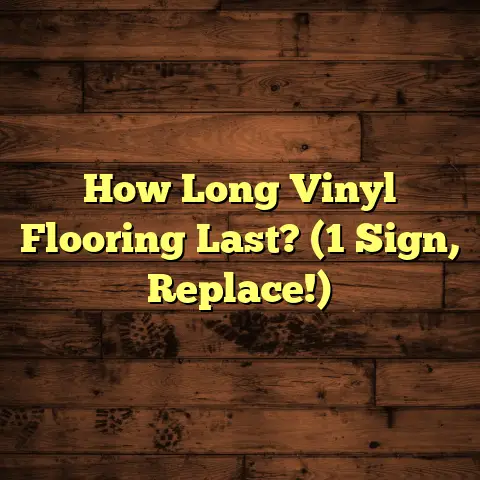Best Gym Flooring: Top Options (6 Revealed!)
I’m excited to dive into a topic that’s close to my heart as a flooring contractor:
Making gyms accessible for everyone.
It’s not just about having the latest equipment or the trendiest classes.
It’s about creating a space where everyone, regardless of their abilities, feels welcome and can work towards their fitness goals.
Think about it: a gym that caters to diverse populations is not only socially responsible but also good for business.
We’re talking athletes, seniors, people with mobility challenges – the whole spectrum.
And guess what? It all starts from the ground up – literally!
The right flooring can make all the difference in safety, performance, and overall inclusivity.
In this article, I’m going to walk you through the best gym flooring options that prioritize accessibility and functionality.
I’ve seen firsthand how the right flooring can transform a gym.
So, let’s get started and build a foundation for a more inclusive fitness future!
Section 1: Understanding the Importance of Gym Flooring
Let’s talk about why gym flooring is more than just a surface to walk on.
It’s a critical component that impacts safety, performance, and accessibility.
I’ve seen countless injuries prevented and workouts enhanced simply by choosing the right flooring.
So, what exactly does gym flooring do?
First, it provides traction.
A non-slip surface is crucial for preventing falls, especially during high-intensity workouts.
Next up: shock absorption.
The right flooring can cushion impact, reducing strain on joints and preventing injuries.
And finally, injury prevention.
By providing a stable and supportive surface, gym flooring can help prevent a wide range of injuries.
But how does flooring impact accessibility?
Different flooring types can either facilitate or hinder movement for users with varying needs.
For example, someone using a wheelchair might struggle on thick, plush carpeting.
While someone with joint pain might find a hard concrete floor unbearable.
It’s all about finding the right balance.
Believe it or not, the flooring you choose can directly impact performance.
A stable, cushioned surface can enhance workouts and support rehabilitation efforts.
I’ve seen athletes lift heavier weights and recover faster simply by switching to a more supportive flooring option.
Here’s a statistic to drive the point home:
According to the CDC, around 61 million adults in the United States live with a disability.
That’s a significant portion of the population that could benefit from more accessible gym environments.
Choosing the right flooring is a crucial step in creating a truly inclusive fitness space.
Section 2: Criteria for Choosing Accessible Gym Flooring
Okay, so how do you choose the right gym flooring for accessibility?
Here are the key criteria I consider when advising my clients:
-
Slip Resistance: This is non-negotiable.
A non-slip surface is essential for preventing falls and ensuring safety for all users.
Look for flooring with a high coefficient of friction (COF). * Cushioning: Shock-absorbing materials can reduce strain on joints and prevent injuries.
This is especially important for high-impact activities like jumping and running. * Durability: Gyms are high-traffic areas, so you need flooring that can withstand heavy use.
Look for materials that are resistant to wear and tear, and that can handle the weight of heavy equipment. * Maintenance: Ease of cleaning and upkeep is crucial for maintaining a hygienic and accessible environment.
Flooring that’s easy to clean and disinfect will help prevent the spread of germs and bacteria. * Aesthetics: While functionality is key, don’t underestimate the importance of visual appeal.
A well-designed gym can enhance the overall experience for all users.
Let’s break down each of these criteria in more detail:
Slip Resistance:
I always tell my clients to prioritize slip resistance above all else.
A slippery floor can be dangerous for anyone, but especially for seniors or people with mobility challenges.
Look for flooring that meets or exceeds ADA (Americans with Disabilities Act) guidelines for slip resistance.
Cushioning:
Cushioning is crucial for protecting joints and preventing injuries.
Think about the types of activities that will be taking place in your gym.
If you have a lot of high-impact activities, you’ll need flooring with more cushioning.
Durability:
Gym flooring takes a beating, so you need something that’s built to last.
Look for materials that are resistant to scratches, dents, and punctures.
And make sure the flooring is properly installed to prevent premature wear and tear.
Maintenance:
Nobody wants to spend hours cleaning the gym floor.
Choose flooring that’s easy to clean and disinfect.
And be sure to follow the manufacturer’s instructions for proper maintenance.
Aesthetics:
Aesthetics might seem like a secondary concern, but they can have a big impact on the overall gym experience.
Choose flooring that’s visually appealing and that complements the overall design of your gym.
A well-designed gym can motivate people to work out and create a more positive atmosphere.
Section 3: Top 6 Gym Flooring Options
Alright, let’s get to the good stuff!
Here are my top six gym flooring options for accessibility, based on my experience:
- Rubber Flooring
- Foam Tiles
- Vinyl Flooring
- Carpet Tiles
- Hardwood Flooring
- Cork Flooring
I’ll break down each option in detail, including its accessibility features, pros and cons, and ideal use cases.
1. Rubber Flooring
Material Overview:
Rubber flooring is a popular choice for gyms due to its durability, shock absorption, and traction properties.
It comes in a variety of forms, including rolls, tiles, and mats.
Accessibility Features:
- Slip Resistance: Rubber flooring is naturally slip-resistant, making it a safe option for all users.
- Cushioning: It provides excellent shock absorption, reducing strain on joints and preventing injuries.
- Durability: Rubber flooring is incredibly durable and can withstand heavy use and abuse.
- Ease of Mobility: Provides a firm, stable surface for wheelchairs and other mobility devices.
Pros and Cons:
- Pros:
- Excellent durability and shock absorption
- Naturally slip-resistant
- Easy to clean and maintain
- Available in a variety of colors and styles
- Cons:
- Can be expensive
- May have a rubbery odor, especially when new
- Can be heavy and difficult to install
Ideal Use Cases:
- Weightlifting areas
- High-impact training zones
- Areas with heavy equipment
- General fitness areas
I’ve seen rubber flooring used successfully in a variety of gym settings.
From small personal training studios to large commercial gyms.
Its durability and shock absorption make it a great choice for areas that see a lot of heavy use.
2. Foam Tiles
Material Overview:
Foam tiles are a popular choice for home gyms and low-impact workout areas.
They’re typically made from EVA foam or other similar materials.
Accessibility Features:
- Cushioning: Foam tiles provide excellent cushioning, making them comfortable for floor exercises and low-impact activities.
- Ease of Installation: They’re easy to install and can be quickly assembled and disassembled.
- Lightweight: Foam tiles are lightweight and easy to move around.
Pros and Cons:
- Pros:
- Affordable
- Easy to install and move
- Provides good cushioning
- Available in a variety of colors and styles
- Cons:
- Not as durable as rubber flooring
- Not suitable for heavy weightlifting or high-impact activities
- Can be slippery when wet
- May not be suitable for wheelchairs due to compression.
Ideal Use Cases:
- Yoga and Pilates studios
- Stretching areas
- Kids’ play areas
- Home gyms
Foam tiles are a great option for creating a comfortable and cushioned workout space.
However, they’re not the best choice for heavy weightlifting or high-impact activities.
3. Vinyl Flooring
Material Overview:
Vinyl flooring is a versatile and durable option that can be used in a variety of gym settings.
It’s available in a wide range of colors, patterns, and styles.
Accessibility Features:
- Ease of Maintenance: Vinyl flooring is easy to clean and maintain, making it a hygienic option for gyms.
- Versatility: It can be used in a variety of areas, including weight rooms, cardio areas, and group fitness studios.
- Slip Resistance: With proper texturing or coatings, vinyl can be made slip-resistant.
- Smooth Surface: Provides a smooth, even surface for easy mobility.
Pros and Cons:
- Pros:
- Durable and long-lasting
- Easy to clean and maintain
- Available in a wide range of styles
- Can be made slip-resistant
- Cons:
- Can be more expensive than some other options
- May require professional installation
- Not as much cushioning as rubber or foam
Ideal Use Cases:
- Cardio areas
- Group fitness studios
- Weight rooms
- Locker rooms
I’ve seen vinyl flooring used successfully in a variety of commercial gyms.
Its durability and versatility make it a great choice for high-traffic areas.
4. Carpet Tiles
Material Overview:
Carpet tiles are a popular choice for gyms that want to create a softer, more comfortable environment.
They’re available in a variety of colors, patterns, and textures.
Accessibility Features:
- Sound Absorption: Carpet tiles can help absorb sound, making the gym a quieter and more pleasant space.
- Comfort: They provide a softer surface than other flooring options, making them more comfortable for floor exercises.
- Safety: Some carpet tiles are designed with enhanced safety features, such as slip resistance and cushioning.
Pros and Cons:
- Pros:
- Absorbs sound
- Provides a softer surface
- Available in a variety of styles
- Can be easy to install
- Cons:
- Can be difficult to clean and maintain
- Not as durable as other options
- Not suitable for heavy weightlifting or high-impact activities
- Can impede wheelchair mobility if too plush.
Ideal Use Cases:
- Yoga and Pilates studios
- Stretching areas
- Reception areas
- Offices
Carpet tiles are a great option for creating a more comfortable and inviting gym environment.
However, they’re not the best choice for areas that see a lot of heavy use or high-impact activities.
5. Hardwood Flooring
Material Overview:
Hardwood flooring is a classic and elegant option that can add a touch of sophistication to any gym.
It’s typically made from oak, maple, or other hardwoods.
Accessibility Features:
- Aesthetic Appeal: Hardwood flooring can enhance the visual appeal of the gym.
- Versatility: It can be used in a variety of spaces, including dance studios, group fitness areas, and multi-purpose rooms.
- Smooth Surface: Provides a smooth, even surface for easy mobility.
Pros and Cons:
- Pros:
- Elegant and stylish
- Durable and long-lasting
- Can increase property value
- Cons:
- Can be expensive
- Requires professional installation
- Can be slippery when wet
- Not as much cushioning as other options
- Requires regular maintenance
Ideal Use Cases:
- Dance studios
- Group fitness areas
- Multi-purpose rooms
- Reception areas
Hardwood flooring can be a great option for gyms that want to create a more upscale and sophisticated environment.
However, it’s important to consider the potential drawbacks, such as cost and maintenance.
6. Cork Flooring
Material Overview:
Cork flooring is a natural and sustainable option that’s becoming increasingly popular in gyms.
It’s made from the bark of cork oak trees.
Accessibility Features:
- Natural Shock Absorption: Cork flooring has natural shock-absorbing qualities, making it comfortable for floor exercises and low-impact activities.
- Eco-Friendly: It’s a sustainable and renewable resource.
- Hypoallergenic: Cork is naturally hypoallergenic and resistant to mold and mildew.
Pros and Cons:
- Pros:
- Sustainable and eco-friendly
- Natural shock absorption
- Hypoallergenic
- Unique and stylish
- Cons:
- Can be more expensive than some other options
- May require professional installation
- Not as durable as rubber or vinyl
- Can be susceptible to dents and scratches
Ideal Use Cases:
- Yoga and Pilates studios
- Stretching areas
- Meditation rooms
- Home gyms
Cork flooring is a great option for gyms that want to create a more natural and sustainable environment.
Its natural shock absorption and hypoallergenic properties make it a good choice for people with sensitivities.
Section 4: Case Studies and Real-World Applications
I’d like to share some real-world examples of gyms that have successfully implemented accessible flooring solutions:
Case Study 1: Inclusive Fitness Center
This fitness center specializes in serving individuals with disabilities.
They chose rubber flooring throughout the gym.
This provides excellent traction and shock absorption for wheelchair users and people with mobility challenges.
The feedback from gym users has been overwhelmingly positive.
Many have reported feeling safer and more confident during their workouts.
Case Study 2: Community Recreation Center
This recreation center serves a diverse population.
They installed a combination of vinyl and carpet tiles.
Vinyl in high-traffic areas and carpet tiles in the yoga and Pilates studios.
This combination provides both durability and comfort for all users.
The center has received awards for its commitment to accessibility.
Case Study 3: Adaptive Training Gym
This gym focuses on adaptive training for athletes with disabilities.
They use a combination of rubber flooring and foam tiles.
This provides customized support and cushioning for various activities.
The gym has been recognized for its innovative approach to adaptive fitness.
These case studies demonstrate that accessible flooring solutions can be successfully implemented in a variety of gym settings.
By prioritizing accessibility, gyms can create a more inclusive and welcoming environment for all users.
Conclusion
Choosing the right gym flooring is crucial for creating an accessible and inclusive fitness environment.
I’ve walked you through the importance of gym flooring.
As well as the key criteria to consider when making your selection.
And I’ve shared my top six gym flooring options for accessibility.
Remember, the right flooring can enhance safety, performance, and overall user experience.
I encourage you to prioritize accessible flooring options in your gym designs.
By doing so, you can create a space where everyone feels welcome and empowered to achieve their fitness goals.
So, take action today and consider the impact of your flooring choices on your gym’s accessibility.
Let’s build a more inclusive fitness future, one floor at a time!





